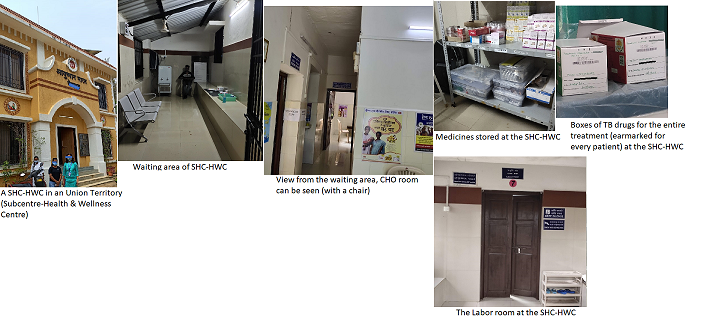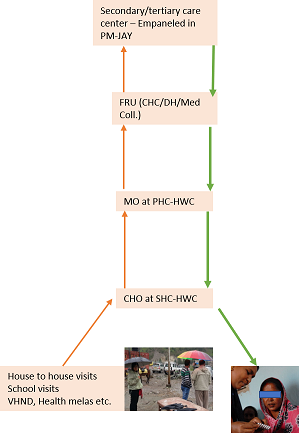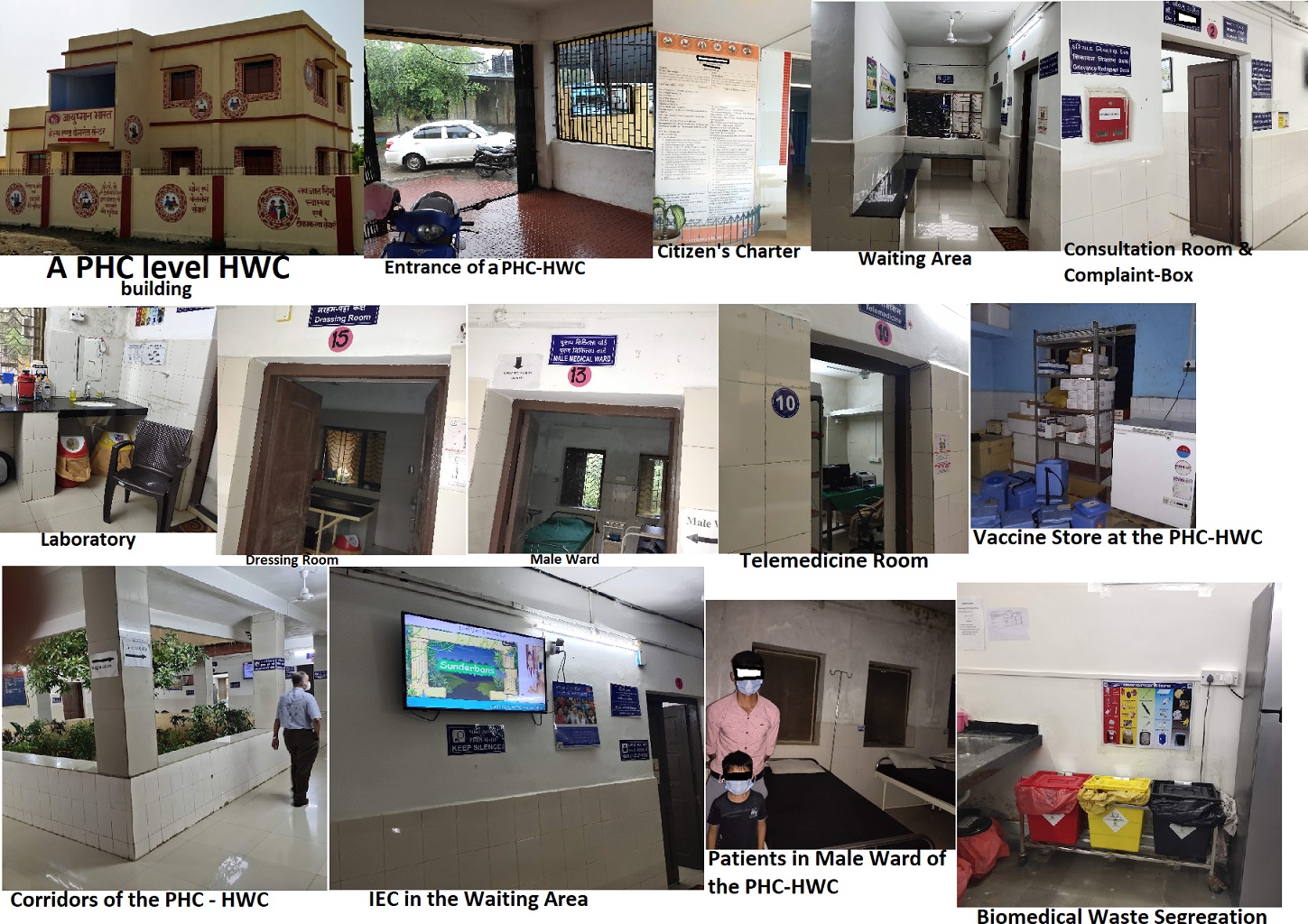
Ayushman Bharat is a Government of India initiative for achieving Universal health coverage (UHC). Universal health coverage (UHC) implies that every individual gets optimum health care without any economic burden. It is a component of the National Health Policy, 2017.
Ayushman Bharat (AB) aims to achieve UHC through two components:
1. Health and Wellness Centres (HWCs): to deliver high quality and free healthcare close to people’s homes. This primary healthcare would cover an expanded package of services in addition to mainly Reproductive and Child Health services as was the case earlier. This expanded package has been called as ‘Comprehensive Primary Health Care’ (CPHC).
HWCs have been likened to ‘Family doctor’ for the poor. Ministry of Health and Family Welfare (MoHFW) has envisaged that only those who need secondary or tertiary level intervention would be referred to higher levels.
2. Pradhan Mantri Jan Arogya Yojana (PM-JAY): It is a health insurance for poor families to provide financial protection for those needing secondary and tertiary care
The previously existing primary health care infrastructure including sub-centres (SHCs), Primary health centres (PHCs), Urban PHCs (UPHCs) across the country are being transformed into corresponding level HWCs. In places where new infrastructure needs to be constructed, detailed lay-out plans have been issued.
It was aimed to establish at least 1,50,000 HWCs countrywide by December 2022.
Two levels of HWCs are taking shape in rural and urban areas:
In rural areas:
a. Upgraded sub-centres (SHC-HWC) and
b. Strengthened Primary Health Centres (PHC-HWC)
In urban areas:
a. Urban HWC (UHWC)
b. Strengthened Urban Primary Health Centres (UPHC-HWC)
The revised IPHS (Indian Public Health Standards) 2022 guidelines classify the HWCs as:
1. Health and Wellness Centres - Primary Health Centre
a) HWC-PHC in rural areas
b) HWC- UPHC in urban areas
2. Health and Wellness Centres - Sub Health Centre:
a) Health and Wellness Centre - Sub Health Centre in rural areas (SHC-HWC)
b) Urban Health & Wellness Centre in urban areas (UHWC)
The aim of HWCs is provision of ‘Continuum of Care’ which includes:
• Healthcare at home and at community level, followed by
• Health services at HWC
• IF NEEDED: referral to secondary and tertiary centres, linked with AB-PMJAY and finally
• Follow – up AFTER discharge from higher centre, continued at home.
Population served per HWC:
In rural areas:
a. SHC-HWC: 5,000 population (3,000 population in hilly/tribal/desert areas)
b. PHC-HWC: 30,000 population (20,000 population in hilly/tribal/desert areas)
In urban areas:
a. Urban HWC (UHWC): 15,000 to 20,000 population
b. UPHC-HWC: 50,000 population
Health team at SHC-HWC level (rural areas):
1. Community Health Officer (CHO)
2. Multi-purpose worker-female (MPW-F) or ANM
3. Multi-purpose worker-male (MPW-M)
4. ASHAs as per the norms
CHO is an addition to the existing team at the sub-centre level. He/she would head the team at the SHC-HCW. CHO is a mid-level health care provider. The essential qualification is BSc Nursing/ GNM/ Ayurveda practitioner. The candidate is given a six months training in primary care (certificate program in community health)
in an approved Certificate Programme in Community Health.
Health team at UHWC level (urban areas):
1. Medical officer
2. Staff nurse
3. Multipurpose worker male
4. Sanitary staff – may be outsourced
5. Security staff – may be outsourced
Health team at PHC/UPHC-HWC level (rural and urban areas):
1. Medical Officer (MBBS)
2. Other staff as per IPHS standards
Indian Public Health Standards, 2022 has released the norms for HWCs at various levels.
These are regarding the following:
• Physical structure and building including ‘Branding’ as per GOI norms
• Minimum area for the HWC, satisfactory location, safety standards
• Electric supply, water supply, energy efficiency, rain water harvesting
• Adequate waiting area with seats and fans
• Rooms for consultation, lab, nursing, dressing, day-care wards etc.
• Clean gender sensitive toilets
• Elderly & disabled friendliness and proper signages
• Bio-medical waste management system
• Essential and desirable medical services list
• Essential medicines to be made available free of cost at each level of HWCs
• Essential lab tests to be made available free of cost at each level of HWCs
In addition, following is to be ensured:
• A ‘Health and Wellness area’:
o For health promotion activities like Yoga, gym, exercises etc. Large enough to accommodate 18 – 20 people.
• Clinical laboratory offering all the essential lab tests as per the list for the level of HCW (i.e. SHC/UHCW/PHC-HWC etc.)
• Teleconsultation area
• Day-care beds
• Oxygen supply
• Complaint and grievance centre
A Citizen’s charter must be placed at the entrance which mentions the following:
• Various services offered at the HWC
• Timings
• Responsibilities of patients and health care workers
• Referral mechanisms and available vehicles for the purpose
• Number of free drugs available
• Number of lab diagnostics provided etc.
Service delivery through HWCs: Health services are delivered at 3 levels:
1. At Family and community level: Through outreach sessions like home visits, Village Health & Nutrition Day (VHND), school visits, Anganwadi visits, village Panchayat meetings etc.
2. At HWC level: 12 services which comprise the ‘Comprehensive Primary Health Care (CPHC)’
3. At the referral facility level: Referral mechanism to the nearest FRU which is ready to promptly manage the referral and opts for two – way referral flow.
Community Ownership:
To ensure sustained efficient functioning of the HWCs in the long run, the beneficiary community has been given the ownership and management of the centres. The community manages the HWC through ‘Jan Arogya Samiti’ (JAS). JAS is a registered body with representatives from local bodies and panchayats. JAS has been given the responsibility of day-to-day management of HWCs and user satisfaction. JAS ensures the accountability of the HWC team.
What has changed with HWCs replacing the previously existing health centers?
The ‘Comprehensive Primary Health Care (CPHC)’ which is to be delivered through the HWCs, include the following 12 services:
1. Care in pregnancy and child-birth.
2. Neonatal and infant health care services.
3. Childhood and adolescent health care services.
4. Family planning, Contraceptive services and other Reproductive Health Care services.
5. Management of Communicable diseases including National Health Programmes.
6. Management of Common Communicable Diseases and Outpatient care for acute simple illnesses and minor ailments.
7. Screening, Prevention, Control and Management of Non-Communicable diseases.
8. Care for Common Ophthalmic and ENT problems.
9. Basic Oral health care
10. Elderly and Palliative health care services.
11. Emergency Medical Services.
12. Screening and Basic management of Mental health ailments.
CPHC is supplemented by outreach services, Mobile Medical Units and care at Home and at the community levels.
Outputs of HWC:
• Issuing Health Cards and Family Health Folder for each household situated in the area served by the HWC. This would ensure that each individual in the area is empanelled to the HWC. The health cards are given to the families and individuals. The family health folders are kept at the HWC or nearby PHC in paper and/or digital format. This will facilitate continuum of care and the families will be aware about their entitlement to healthcare through the HWC and to health insurance if any.
• An increase in the range of healthcare services as compared to what is currently available.
Outcomes:
• Improvement in population coverage by healthcare services
• Reduction in out-of-pocket expenditure (OOPE): Increased range of free medicines and diagnostics along with case-coordination by two-way referral system, would reduce the catastrophic expenditure on health.
• Awareness regarding healthy lifestyle and early identification of risk factors can help in the control of NCDs.
• Reduction in patient overcrowding at secondary and tertiary health units. Only complicated cases would need to be referred to these and the follow-up after treatment is done by the HWC team, as instructed by the clinicians at these facilities.
How is the quality of health care services ensured with AB – HWCs
1. Jan Arogya Samiti (JAS) accountability – The beneficiary population has been tasked with planning, managing and ensuring accountability through JAS.
J A samitis have been formed at both SHC/UHCW and PHC/UPHC levels of HWCs, both in rural and urban areas.
At SHC-HWC level, it comprises of:
• Chair-person: Sarpanch of the gram panchayats of villages in the HWC area
• Co-chair: Medical Officer at the designated PHC
• Member-secretary: Community Health Officer of the HWC
• Other sarpanch
• VHNSC presidents
• ASHAs
• School health & wellness ambassadors
• Peer educators
• Any patient support group, TB survivor etc as special invitees
• Others
The JAS is registered society. JAS is supposed to conduct monthly meetings. It has been allocated certain funds for supporting the essential requirements for HWC.
JAS is expected to take feedback from community in form of Jan-Sunwais, Jan-Samwads and prompt and appropriate action is to be taken based on the feedback received.
2. Standard treatment guidelines have been issued by the ministry
3. Citizen’s charter: the users are aware of the services available at the HWC
4. Complaint centre and redressal by JAS and higher authorities if needed
School Health activities under Ayushman Bharat Scheme:
The teachers in the schools under the HWC are being trained to act as Health and Wellness Ambassadors; the students as HW messengers.
School age is the impressionable age and health habits developed at this stage affects the future health as adults. This can prevent lifestyle diseases in later life.
Health Promotion areas covered under Ayushman Bharat scheme:
Seven priority areas have been included as part of CPHC.
1. The Swachh Bharat Abhiyan.
2. Balanced, healthy diets and regular exercises.
3. Addressing tobacco, alcohol and substance abuse.
4. Yatri Suraksha – preventing deaths due to rail and road traffic accidents.
5. Nirbhaya Nari –action against gender violence.
6. Reduced stress and improved safety in the work place.
7. Reducing indoor and outdoor air pollution.
References:
1. GOI, 2018. AYUSHMAN BHARAT, Comprehensive Primary Health Care through Health and Wellness Centers; Operational Guidelines. National Health Mission, Ministry of Health and Family Welfare, New Delhi, India. Available at: https://www.nhm.gov.in/New_Updates_2018/NHM_Components/Health_System_Str...
2. GOI, 2021. Ayushman Bharat Health and Wellness Centres, Transforming India’s Primary Health Care System Ministry of Health and Family Welfare, New Delhi, India. Available at: https://nhm.gov.in/New_Updates_2018/publication/AB-HWC-Brochure-March-20...
3. GOI, 2021. AYUSHMAN BHARAT HEALTH AND WELLNESS CENTRES. Ministry of Health and Family Welfare, New Delhi, India. Available at: https://static.pib.gov.in/WriteReadData/specificdocs/documents/2021/sep/...
4. GOI, 2022. INDIAN PUBLIC HEALTH STANDARDS, Health and wellness centre-Sub
health centre 2022, Volume-IV, Ministry of Health & Family Welfare, New Delhi, India Available at: https://nhsrcindia.org/sites/default/files/SHC-HWC%20%26%20UHWC%20IPHS%2...
5. GOI, 2022. INDIAN PUBLIC HEALTH STANDARDS, Health and wellness centre-Primary health centre 2022, Volume-III, Ministry of Health & Family Welfare, New Delhi, India Available at: https://nhm.gov.in/images/pdf/guidelines/iphs/iphs-revised-guidlines-202...
6. GOI, 2022. AYUSHMAN BHARAT: HEALTH AND WELLNESS CENTERS, REALISING UNIVERSAL HEALTH CARE. Ministry of Health and Family Welfare, New Delhi, India. Available at: https://nhm.gov.in/infocus/HWCs_Booklet_English_updated_5_April_2022.pdf
